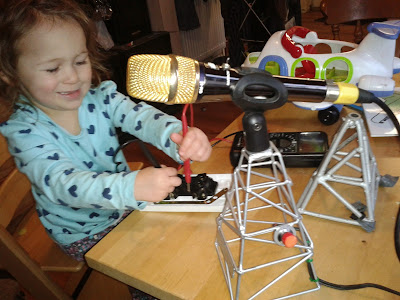Homebrew Microphone Mast

I can't quite remember just how many years I have been planning on replacing my prototype microphone mast/stand, yesterday I finally made myself a shiny new one! I engineered my latest home brew microphone stand to house my HEiL GM-5 studio mic at the perfect height for my operations. The early design was made from 6mm round bar making it heavy so this time I opted for some 3mm TIG welding wire making the new mast very light. I cut my wire to the required lengths during the assembly, which I carried out with the TIG Tungsten Inert Gas welding process. Once completed, I gave it a coat of aluminum aerosol paint and left it to dry overnight. This afternoon my daughter/apprentice and I began to assemble the microphone head mount and PTT switch to the new mast which also involved getting the soldering iron out (-: more fun :-). We checked the soldered joints with the multimeter which was the best thing ever for my new tech especially when I found an old electrical switch t


